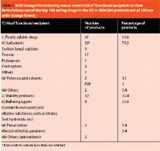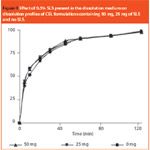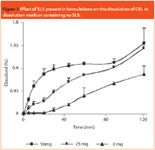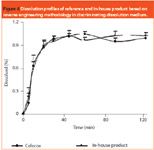Criticality of functional excipients and decoding methods during generic product development
Pharmaceutical Technology Europe
Bioequivalence with the reference product is the only reliable measure of demonstrating the therapeutic equivalence of a generic product to the innovator product. Systematic and comprehensive innovator product characterization can be used to make generic product development easier. This involves characterization of API and quantification of the critical excipients. The latter contributes towards performance of the final dosage form. This article describes the capsule formulation of a poorly water-soluble drug, celecoxib, which contains sodium lauryl sulphate as a critical excipient. The importance of a decoding process aimed at developing a generic product that matches the innovator formulation in a discriminating dissolution method is demonstrated.
Generic drugs offer a cost-effective substitute for high priced innovator or branded products and play an important role in reducing spending on prescription drugs, especially in the case of a chronic treatment. The generic industry operates at a relatively low investment, low risk, and concentrates on developing low-cost products of off-patent molecules.1
Introduction of the drug price competition and patent term restoration act (Hatch–Waxman) amendments in the US has led to significant increase in the number of generic products filed. Generics share in US prescription drug market today has risen to nearly 50% in volume compared with 19% in 1984, the time when the Hatch–Waxman act was enacted.
The cost of marketing a new drug is about $802 million and involves an average time of 14 years compared with an investment of $1–2 million and an average time of 3–5 years for its generic counterpart.2,3 Recent figures indicate a growth rate of 24% for generics in the US, while it is only 8% for branded products and forthcoming patent expirations of about 50 blockbuster drugs will further boost the prospects of generic products.4–6
Generic product development typically consists of preformulation studies, prototype formulation development, scale-up, bioequivalence testing and finally abbreviated new drug application (ANDA) submission. Although the Hatch–Waxman act has eliminated the duplicative clinical trials required for generic product approval, a generic applicant must scientifically demonstrate that its product is a 'therapeutic equivalent' to the innovator product.
This includes pharmaceutical equivalence (contains the same active ingredient[s] at the same strength, similar dosage form with same route of administration) and bioequivalence (similar in vivo performance as that of the reference listed drug).
Bioequivalence remains the most crucial development step and contributes significant costs of about $250000 and is therefore the highest risk.7
The most sensible strategy for the development of a bioequivalent generic product would be to match innovator formulation qualitatively and quantitatively, which requires comprehensive characterization of innovator formulation with respect to solid-state properties of the active pharmaceutical ingredient (API), identification and quantitative determinations of critical excipients, and identification of the manufacturing process.
A decision tree on the development of generic products has been proposed, taking into consideration various aspects, such as physicochemical properties of the API and excipients.8
Generic products containing an API belonging to the biopharmaceuticals classification system (BCS) class II would benefit more from the innovator product characterization because of the greater sensitivity of these products to composition and manufacturing process to achieve bioequivalence. Particle size reduction of APIs and inclusion of solubility modifying excipients are the preferred strategies to improve oral bioavailability in such cases.
Critical excipients in solid dosage forms
Apart from dissolution/solubility modifying agents various other categories of critical excipients are generally included in various formulations. Some of them are stabilizers, preservatives and buffering agents. We studied the qualitative formulae of 100 top-selling formulations of 2004 for the presence of critical or functional excipients. The frequency of occurrence of various 'critical' excipients is listed in Table 1.9

Table 1 Solid dosage forms having one or more ôcriticalô functional excipients in their formulations out of the top 100 selling drugs in the US in 2004 (69 products out of 100 are solid dosage forms).
Out of 100 top-selling products, about 69 products are solid dosage forms and 37 (53.6%) of these solid dosage forms contain drug substances having solubility problems (sparingly or poorly soluble). Out of these products, many contain solubility/dissolution modifying agents such as surfactants, solvents or polymers.

Figure 1 Effect of 0.5% SLS present in the dissolution medium on dissolution profiles of CEL formulations containing 50 mg, 25 mg of SLS and no SLS.
Surfactants constituted a major section of these with about 70.3% share, while four products contained more than one surfactant. The other components added into these solid dosage forms are the stabilizers, either as buffers (pH-modifying) or preservatives or antioxidants.
About 32.4% of products contained one or more stabilizers in their formulations. Looking at the widespread use of solubilizers in delivery of poorly soluble drugs, a study was performed to identify the criticality of sodium lauryl sulphate (SLS), as a solubility modifier in the capsule formulation of celecoxib (CEL). CEL is a widely used selective COX-2 inhibitor which exhibits very poor aqueous solubility and thus solubility limited absorption.10
It is marketed as a capsule formulation under the brand name Celebrex by its innovator company, Pharmacia Upjohn. The label of Celebrex claims the qualitative formula as lactose monohydrate, povidone, sodium lauryl sulphate, crosscarmellose sodium, and magnesium stearate, as well as the labelled amount of CEL.
A number of generic versions of Celebrex are available in the Indian market. Celcox (Lupin Pharma, India) was selected as a reference formulation instead of Celebrex because of the non-availability of the latter. The formulation was characterized and the role and importance of functional excipients added into it was explored using a discriminatory dissolution method.
Materials
CEL was purchased from Cadila Healthcare (India). Dissolution medium components, that is, SLS, sodium dihydrogen phosphate dihydrate, and sodium hydroxide were purchased from Loba Chemie (India). Formulation excipients such as lactose monohydrate and crosscarmellose sodium were purchased from Meggle Group (Germany) and JRS (Germany) respectively.
Magnesium stearate and polyvinyl pyrrolidone K–30 (PVP) were gifted by Fine Chemical Laboratories (India) and ISP Tech (USA), respectively. All chemicals used were of analytical grade and were used as received.
Development of discriminating dissolution method
A simple dissolution method was developed and utilized to discriminate the effects of SLS added into the formulation. A phosphate buffer of pH 6.8 with varying content of SLS was screened for the purpose. 'In-house' formulations of CEL were prepared without SLS and with 15 mg, 25 mg and 50 mg of SLS.
The dissolution studies were performed using USP 24 apparatus-II at 75 rpm and at 37 °C in vessels containing 900 mL of buffer. Samples were withdrawn in 5 mL aliquots at specified time intervals (and replaced with fresh buffer) and analysed spectrophotometrically at 254 nm to obtain the dissolution profiles.
Formulation analysis
The quantification of few of the ingredients of Celecox was achieved by chromatography. The identification and quantification of SLS, PVP and lactose present in the formulations was done using in-house developed and validated liquid chromatographic methods (HPLC System from Shimadzu Corporation [Japan]).
The separation of PVP was achieved on an Ultrahydrogel 500 column (7.8 × 300 mm, 500 Å) and an Ultrahydrogel guard column (Waters, Massachusetts, USA) using 25 mM sodium phosphate buffer containing 5 mM of sodium hexane sulfonate, at a flow rate of 0.9 mL/min and detection was performed at 205 nm.
The quantification of SLS was performed using a similar column as above using 25 mM sodium phosphate buffer, but using a refractive index (RI) detector. The analysis of lactose was performed using water as mobile phase on LiChrocart 250-4, LiChroSpher 100 RP 18 (250 mm × 4.6 mm, 5 μm) and a guard column of LiChrocart 4-4, LiChroSpher RP 18 endcapped (Merck, Germany).
Results and discussion
Formulation of in-house/test product — unit formula estimation.
The qualitative formulation of Celebrex as obtained from Physicians Desk Reference includes SLS, povidone, lactose monohydrate, croscarmellose sodium and magnesium stearate apart from the labelled amount of celecoxib.
SLS was identified as the critical excipient. Confirmation of presence and quantification of SLS in Celecox was performed using an in-house developed size exclusion HPLC method. Additionally, quantification of povidone and lactose in Celcox was performed using different validated HPLC methods developed in our laboratory. Based on these analyses, the unit formula for the in-house formulation was developed on the following lines.
The net content of Celcox capsules was determined as 275 mg. The quantified amounts of lactose monohydrate, povidone and SLS in the formulation were found to be 45 mg, 1.5 mg and 15 mg respectively, and these were subtracted along with the labelled amount of CEL (200 mg) from the total weight of capsule.
Concentration of magnesium stearate was fixed at 1.5% based on its normal usage concentration of 1–2%. The final weight of the capsule was adjusted to 275 mg by incorporating 10 mg of croscarmellose sodium.
Identification of manufacturing process
The microscopic observation (Leica DMLP, Germany) of powder contents of Celcox capsules revealed no useful information about the manufacturing process. CEL is practically insoluble in water, and when CEL was added in its native crystalline form to the dissolution medium it floated on the surface.
Similarly simple mixing of the components according to the unit formula specified above, resulted in floating of the formulation mix although it contains SLS. But, the contents of reference formulation were found to wet quickly. This indicates that SLS is either added in the solution form and mixed well or high-shear mixing was employed.
However, absence of granules in the reference product eliminates the possibility of usage of SLS in solution form or wet granulation method. Blending of components in a mortar and pestle produced a powder, which is not only similar in appearance to reference, but also matched in wetting characteristics thus indicating use of high-shear mixing for manufacturing of the formulation.
The in-house or test formulation was developed by titrating the components as per the unit formula in a mortar with pestle, applying the principle of above deduced manufacturing process of using high- shear mixing. These test formulations were further evaluated and compared with reference formulation.
Discriminating dissolution method
A drug in the solution form at the site of absorption is a prerequisite for the absorption process and hence dissolution acts as an important quality control (QC) technique for solid oral dosage forms for assuring batch-to-batch similarity and bioequivalence.
Dissolution tests can act as a surrogate for the latter only if it is sensitive enough to discriminate between 'good' and 'bad' formulations. In the present context, SLS was identified as the 'critical' excipient for dissolution and hence dissolution methodology should be able to discriminate the effect of various concentrations of SLS.
In the absence of a compendial monograph of CEL, a dissolution method using phosphate buffer of pH 6.8 was developed. Regarding the compendial requirements, the amount of buffer in the dissolution vessel should provide sink conditions, that is, three times the solubility of the amount of drug present in the formulation.11 As a common practice, surfactants are incorporated into dissolution media for poorly soluble drugs to meet the above requirement. Hence, SLS was incorporated into the dissolution medium for CEL formulations.
Phosphate buffers of pH 6.8 were prepared containing various concentrations of SLS; 1%, 0.5%, 0.25% and no SLS were prepared, and the their influence on dissolution of CEL was analysed as explained below. Also in-house formulations containing various concentrations of SLS were prepared and the effect on dissolution profiles was recorded.
Evaluation of effect of SLS on dissolution of CEL
The literature shows wide usage of SLS in dissolution media.12–14 The dissolution profiles of three formulations containing 50 mg, 25 mg of SLS (18% and 9% w/w of the total weight) and no SLS was performed in a dissolution medium containing 0.5% w/w of SLS (Figure 1). The figure shows no significant difference between the dissolution profiles of three formulations containing considerably different amounts of SLS, thus proving non-discriminatory nature of the dissolution medium. Hence, it can be conjectured that creation of sink conditions in dissolution medium can reduce its capability to discriminate effect of 'critical' excipients.

Figure 2 Effect of SLS present in the dissolution medium on the dissolution profile of CEL.
Similarly, the effect of SLS concentration present in dissolution medium on dissolution profile of an in-house prepared CEL formulation containing 25 mg of SLS (9% w/w of tablet weight) was studied and is presented in Figure 2. Here also almost over-lapping dissolution profiles in all the dissolution media were obtained.
As the next strategy, pH 6.8 phosphate buffer without SLS was used as dissolution buffer, although it does not provide sink condition as per the compendial requirements.

Figure 3 Effect of SLS present in formulations on the dissolution of CEL in dissolution medium containing no SLS.
Three formulations containing 50 mg, 25 mg of SLS and no SLS, were evaluated in the dissolution medium. The dissolution profile of the formulation containing no SLS showed incomplete solubilization of CEL.
However, the dissolution medium could discriminate between various concentrations of SLS (Figure 3). Addition of even 25 mg of SLS into the formulation drastically improved the dissolution of CEL. These results stress on two important issues
- The criticality of the concentration of functional excipients on dissolution performance of formulations.
- Developing an analytical tool sensitive enough to discriminate their effect on dissolution.
Comparison of dissolution profiles of reference and test formulations
The 'discriminatory' dissolution method was now used to statistically compare the in-house formulation with the reference product (Figure 4).

Figure 4 Dissolution profiles of reference and in-house product based on reverse engineering methodology in discriminating dissolution medium.
A very good similarity for the dissolution profiles (f2 = 99.97) was observed between test and reference formulations, in the discriminating dissolution medium.15,16 This further proves the assumption that, targeting critical excipients in innovator formulation can help to increase the chances of bioequivalence.
Taking a case study of one poorly soluble drug molecule, CEL, the role and importance of SLS, a solubilizer, added into its formulation, is demonstrated, by showing the failure of regularly used dissolution medium to identify the minor differences between in-house and reference formulations, and how the decoding of reference formulation helps in overcoming the obstacles anticipated during bioequivalence testing.
The in-house product which is qualitatively and quantitatively similar to that of reference product was developed by delineating two steps:
- The complete decoding of the unit formula of reference formulation
- The identification of manufacturing process applied in preparing the reference formulation.
Conclusions
The safe and foremost strategy during generic product development is to use same qualitative formula as that of the innovator product to minimize the stability and compatibility related risks.
Matching qualitative formula only may not suffice to meet the strategic criteria of bioequivalence, which may further demand similar quantitative formula. As in most of the cases it would be difficult to completely decode the quantitative formula, the approach of matching the critical components of the formulation such as functional excipients is recommended.
The speculations were confirmed experimentally by taking a case study of a poorly soluble drug, CEL, and using dissolution as a surrogate for bioequivalence. The present study clearly demonstrates that identification and quantitative matching of critical excipients can give better chances of meeting.
Mudassar Mulla is a postgraduate from the department of pharmaceutical technology (formulations), NIPER, India.
Vasu Kumar Kakumanu is a PhD scholar in the department of pharmaceutical technology (formulations), NIPER, India.
Arvind K. Bansal is an associate professor at the department of pharmaceutical technology (formulations), NIPER, India.
References
1. D.M. Kirking, J. Amer. Pharm. Assoc. 41(4) 517–518 (2001).
2. A.C. Jones, Scrip123 13–15 (2003).
3. C.P. Milne and C. Cairns, Pharm. Dev. Regulations1(1) 11–17 (2003).
4. Anon, Scrip Daily (March), 1–3 (2004).
5. J.M. Peny, Scrip122 13–17 (2003).
6. W.F. Jakob and Y.H. Kwak, Technovation 23(4), 291-296 (2003).
7. J.A. Cook and H.N. Bockbrader, Disso. Technol.9(2) 25–27 (2002).
8. A.K. Bansal and V. Koradia, Pharm. Tech. 29(8), 50–55 (2005).
9. www.rxlist.com/top200_sales_2004.htm (Accessed on Sept 2005).
10. S.K. Paulson et al., J. Pharmacol. Expt. Therap. 297(2) 638–645 (2001).
11. B.R. Rohrs, Disso. Technol.8(8), 1–5 (2001).
12. J.B. Dressman et al., Pharm. Res. 15(1) 11–22 (1998).
13. J.R. Crison, N.D. Weiner and G.L. Amidon, J. Pharm. Sci.86(3) 384–388 (1997).
14. V.P. Shah et al., Pharm. Res.6(7) 612–618 (1989).
15. P. Costa and J.M.S. Lobo, Eur. J. Pharm. Sci.13(2) 123–133 (2001).
16. T. Hara et al., Pharm. Sci. Tech. Today1(5) (1998).?

Drug Solutions Podcast: A Closer Look at mRNA in Oncology and Vaccines
April 30th 2024In this episode fo the Drug Solutions Podcast, etherna’s vice-president of Technology and Innovation, Stefaan De Koker, discusses the merits and challenges of using mRNA as the foundation for therapeutics in oncology as well as for vaccines.
Pharmaceutical Tariffs Are Imminent: How Industry is Bracing for Impact
April 16th 2025On April 14, 2025, the Trump Administration launched a national security-driven investigation into pharmaceuticals, a move that will likely result in tariffs being placed on pharmaceutical drugs, ingredients, and other components that are imported from outside of the United States.